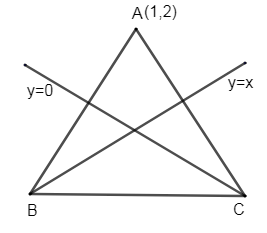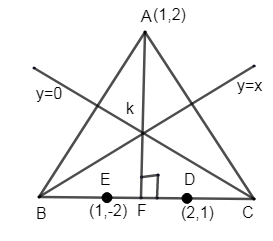
Select the correct options:
In a triangle ABC, the bisector of the angles B and C lie along the line x = y and y = 0. If A is (1, 2) then \[\sqrt{10}d\left( A,B,C \right)\] where \[d\left( A,B,C \right)\] represents distance of point A from side BC
A. 1
B. 4
C. 3
D. 5
E. 0
Answer
597k+ views
Hint: Draw \[\Delta ABC\] and bisect \[\angle B\] and \[\angle C\] by line x = y and y = 0. Now find the image of A w.r.t line y =x which can be taken as D and find the image of a w.r.t to line y = 0, which is E on BC. Find equation of line BC. Draw \[AF\bot BC\]. Using a perpendicular distance formula, get the value of \[\sqrt{10}d\left( A,B,C \right)\].
Complete Step-by-Step solution:
Let us draw a triangle ABC, as in figure. Angle B is bisected by the line y = x and angle C is bisected by the line y = 0. Given point, A = (1, 2).

Now we need to find the image of point A, with respect to the line y = x.
Thus from the figure we can see that the image of point A w.r.t to line y = x is (2, 1).

Thus let us mark it as E = (1, -2).

Thus equation of line BC can be formed by the equation,
\[\dfrac{y-{{y}_{1}}}{{{y}_{2}}-{{y}_{1}}}=\dfrac{x-{{x}_{1}}}{{{x}_{2}}-{{x}_{1}}}\Rightarrow \dfrac{y-\left( -2 \right)}{1-\left( -2 \right)}=\dfrac{x-1}{2-1}\]
\[\left\{ \begin{align}
& \because \left( {{x}_{1}},{{y}_{1}} \right)=\left( 1,-2 \right) \\
& \left( {{x}_{2}},{{y}_{2}} \right)=\left( 2,1 \right) \\
\end{align} \right\}\]
\[\therefore \dfrac{y+2}{1+2}=\dfrac{x-1}{2-1}\], use cross multiplication property.
\[\begin{align}
& 1\left( y+2 \right)=3\left( x-1 \right) \\
& \therefore y+2=3x-3 \\
& 3x-y=5 \\
\end{align}\]
Now we need the distance of AF, which is perpendicular to the base BC.
Now let us use the perpendicular distance formula.
Here \[3x-y=5\] is of the form \[ax+by+c\] and \[\left( x,y \right)=\left( 1,2 \right)\].
\[\begin{align}
& d=\dfrac{\left| ax+by+c \right|}{\sqrt{{{a}^{2}}+{{b}^{2}}}} \\
& \therefore d=\dfrac{\left| \left( 3\times 1 \right)+\left( 2\times -1 \right)-5 \right|}{\sqrt{{{3}^{2}}+{{\left( -1 \right)}^{2}}}}=\dfrac{\left| 3-2-5 \right|}{\sqrt{9+1}}=\dfrac{\left| -4 \right|}{\sqrt{10}}=\dfrac{4}{\sqrt{10}} \\
\end{align}\]
\[\therefore d\left( A,B,C \right)=\dfrac{4}{\sqrt{10}}\], cross multiply \[\sqrt{10}\].
Hence, we got, \[\sqrt{10}d\left( A,B,C \right)=4\].
Hence we got the value of \[\sqrt{10}d\left( A,B,C \right)=4\].
\[\therefore \] Option (b) is the correct answer.
Note: It is important to take the image of point A w.r.t the line y = x and y = 0. Then only you get the equation of line of BC. We have been given the hint that d (A, B, C) is the distance from A to side BC, which means that we have to use the perpendicular distance formula.
Complete Step-by-Step solution:
Let us draw a triangle ABC, as in figure. Angle B is bisected by the line y = x and angle C is bisected by the line y = 0. Given point, A = (1, 2).

Now we need to find the image of point A, with respect to the line y = x.
Thus from the figure we can see that the image of point A w.r.t to line y = x is (2, 1).

Thus let us mark it as E = (1, -2).

Thus equation of line BC can be formed by the equation,
\[\dfrac{y-{{y}_{1}}}{{{y}_{2}}-{{y}_{1}}}=\dfrac{x-{{x}_{1}}}{{{x}_{2}}-{{x}_{1}}}\Rightarrow \dfrac{y-\left( -2 \right)}{1-\left( -2 \right)}=\dfrac{x-1}{2-1}\]
\[\left\{ \begin{align}
& \because \left( {{x}_{1}},{{y}_{1}} \right)=\left( 1,-2 \right) \\
& \left( {{x}_{2}},{{y}_{2}} \right)=\left( 2,1 \right) \\
\end{align} \right\}\]
\[\therefore \dfrac{y+2}{1+2}=\dfrac{x-1}{2-1}\], use cross multiplication property.
\[\begin{align}
& 1\left( y+2 \right)=3\left( x-1 \right) \\
& \therefore y+2=3x-3 \\
& 3x-y=5 \\
\end{align}\]
Now we need the distance of AF, which is perpendicular to the base BC.
Now let us use the perpendicular distance formula.
Here \[3x-y=5\] is of the form \[ax+by+c\] and \[\left( x,y \right)=\left( 1,2 \right)\].
\[\begin{align}
& d=\dfrac{\left| ax+by+c \right|}{\sqrt{{{a}^{2}}+{{b}^{2}}}} \\
& \therefore d=\dfrac{\left| \left( 3\times 1 \right)+\left( 2\times -1 \right)-5 \right|}{\sqrt{{{3}^{2}}+{{\left( -1 \right)}^{2}}}}=\dfrac{\left| 3-2-5 \right|}{\sqrt{9+1}}=\dfrac{\left| -4 \right|}{\sqrt{10}}=\dfrac{4}{\sqrt{10}} \\
\end{align}\]
\[\therefore d\left( A,B,C \right)=\dfrac{4}{\sqrt{10}}\], cross multiply \[\sqrt{10}\].
Hence, we got, \[\sqrt{10}d\left( A,B,C \right)=4\].
Hence we got the value of \[\sqrt{10}d\left( A,B,C \right)=4\].
\[\therefore \] Option (b) is the correct answer.
Note: It is important to take the image of point A w.r.t the line y = x and y = 0. Then only you get the equation of line of BC. We have been given the hint that d (A, B, C) is the distance from A to side BC, which means that we have to use the perpendicular distance formula.
Recently Updated Pages
Two men on either side of the cliff 90m height observe class 10 maths CBSE

What happens to glucose which enters nephron along class 10 biology CBSE

Cutting of the Chinese melon means A The business and class 10 social science CBSE

Write a dialogue with at least ten utterances between class 10 english CBSE

Show an aquatic food chain using the following organisms class 10 biology CBSE

A circle is inscribed in an equilateral triangle and class 10 maths CBSE

Trending doubts
Why is there a time difference of about 5 hours between class 10 social science CBSE

Write a letter to the principal requesting him to grant class 10 english CBSE

What is the median of the first 10 natural numbers class 10 maths CBSE

The Equation xxx + 2 is Satisfied when x is Equal to Class 10 Maths

Which of the following does not have a fundamental class 10 physics CBSE

State and prove converse of BPT Basic Proportionality class 10 maths CBSE




